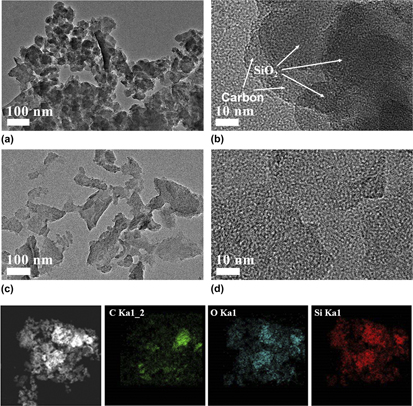Crossref Citations
This article has been cited by the following publications. This list is generated based on data provided by
Crossref.
Autthawong, Thanapat
Namsar, Orapim
Yu, Aishui
and
Sarakonsri, Thapanee
2020.
Cost-effective production of SiO2/C and Si/C composites derived from rice husk for advanced lithium-ion battery anodes.
Journal of Materials Science: Materials in Electronics,
Vol. 31,
Issue. 12,
p.
9126.
Pang, Haibo
Zhang, Weicai
Yu, Peifeng
Pan, Ning
Hu, Hang
Zheng, Mingtao
Xiao, Yong
Liu, Yingliang
and
Liang, Yeru
2020.
Facile Synthesis of Core-Shell Structured SiO2@Carbon Composite Nanorods for High-Performance Lithium-Ion Batteries.
Nanomaterials,
Vol. 10,
Issue. 3,
p.
513.
Lee, Seunghyun
Yoon, Jaesang
Yoon, Won-Sub
and
Son, Yongkeun
2020.
Synthesis of ceria-carbon composite spheres and their application for next-generation lithium rechargeable batteries.
Journal of Alloys and Compounds,
Vol. 837,
Issue. ,
p.
155467.
Sharma, Jaswinder
and
Polizos, Georgios
2020.
Hollow Silica Particles: Recent Progress and Future Perspectives.
Nanomaterials,
Vol. 10,
Issue. 8,
p.
1599.
Balaban, O.
Mitina, N.
Zaichenko, A.
Paiuk, O.
and
Shermolovich, Yu.
2020.
Functional Polymer Coated MoS2 Nanocomposites as Promising Lithium Current Sources.
p.
02NEE14-1.
Liang, Jiang
Yang, Shangze
Ye, Liang
Li, Xiaolu
Yang, Xianfeng
Chen, Shuguang
and
Liu, Peng
2021.
In situ synthesis of silica/graphite anode material with enhanced lithium storage performance.
Journal of Materials Science: Materials in Electronics,
Vol. 32,
Issue. 24,
p.
28119.
Li, Dawei
Zhang, Xiaoxiao
Wang, Yu
Yan, Xilu
Zong, Peijie
Lu, Guixia
and
Tian, Yuanyu
2021.
Activation of rice hull char with steam to improve lithium storage performance of SiO2/C.
Journal of Analytical and Applied Pyrolysis,
Vol. 157,
Issue. ,
p.
105185.
Dawei, Li
Xiaoxiao, Zhang
Yu, Wang
Peijie, Zong
Li, Zhang
Zongbo, Zhang
Xin, Gu
Yingyun, Qiao
Guixia, Lu
and
Yuanyu, Tian
2021.
Adjusting ash content of char to enhance lithium storage performance of rice husk-based SiO2/C.
Journal of Alloys and Compounds,
Vol. 854,
Issue. ,
p.
156986.
Buga, Mihaela-Ramona
Spinu-Zaulet, Adnana Alina
Ungureanu, Cosmin Giorgian
Mitran, Raul-Augustin
Vasile, Eugeniu
Florea, Mihaela
and
Neatu, Florentina
2021.
Carbon-Coated SiO2 Composites as Promising Anode Material for Li-Ion Batteries.
Molecules,
Vol. 26,
Issue. 15,
p.
4531.
Al Ja’farawy, Muhammad Shalahuddin
Hikmah, Dewi Nur
Riyadi, Untung
Purwanto, Agus
and
Widiyandari, Hendri
2021.
A Review: The Development of SiO2/C Anode Materials for Lithium-Ion Batteries.
Journal of Electronic Materials,
Vol. 50,
Issue. 12,
p.
6667.
Wang, Dan
Wang, Tongshuai
He, Miao
Wang, Ting
and
Wang, Hailong
2021.
Carbon Yarn‐Ball‐Entangled SiO2 Anode with Excellent Electrochemical Performance for Lithium‐Ion Batteries.
Small,
Vol. 17,
Issue. 49,
Renman, Viktor
Blanco, Maria Valeria
Norberg, Andreas Nicolai
Vullum-Bruer, Fride
and
Svensson, Ann Mari
2021.
Electrochemical activation of a diatom-derived SiO2/C composite anode and its implementation in a lithium ion battery.
Solid State Ionics,
Vol. 371,
Issue. ,
p.
115766.
Phat, Vu Tan
Thu, Chu Thi Minh
Trung, Nguyen Thien
Phung, Le My Loan
Kaveevivitchai, Watchareeya
and
Van Man, Tran
2022.
Structure and electrochemical properties of surface‐activated C/
SiO
2
composite derived from rice husks as a high‐performance anode for sodium‐ion batteries
.
International Journal of Energy Research,
Vol. 46,
Issue. 15,
p.
21727.
Ratsameetammajak, Natthakan
Autthawong, Thanapat
Chairuangsri, Torranin
Kurata, Hiroki
Yu, Ai-shui
and
Sarakonsri, Thapanee
2022.
Rice husk-derived nano-SiO2assembled on reduced graphene oxide distributed on conductive flexible polyaniline frameworks towards high-performance lithium-ion batteries.
RSC Advances,
Vol. 12,
Issue. 23,
p.
14621.
Namsar, Orapim
Autthawong, Thanapat
Boonprachai, Ruttapol
Yu, Aishui
and
Sarakonsri, Thapanee
2022.
Enhancement in lithium storage performances of SiO2/graphene-based nanocomposites prepared by low cost and facile approach.
Journal of Materials Science: Materials in Electronics,
Vol. 33,
Issue. 9,
p.
6536.
Autthawong, Thanapat
Yodbunork, Chawin
Ratsameetammajak, Natthakan
Namsar, Orapim
Chimupala, Yothin
and
Sarakonsri, Thapanee
2022.
Enhanced Electrochemical Performance of Sn(SnO2)/TiO2(B) Nanocomposite Anode Materials with Ultrafast Charging and Stable Cycling for High-Performance Lithium-Ion Batteries.
ACS Applied Energy Materials,
Vol. 5,
Issue. 11,
p.
13829.
Divya, Madhusoodhanan Lathika
Lee, Yun‐Sung
and
Aravindan, Vanchiappan
2022.
Pencil Powered Faradaic Electrode for Lithium‐Ion Capacitors with High Energy and Wide Temperature Operation.
Batteries & Supercaps,
Vol. 5,
Issue. 9,
Sujithkrishnan, Elayaperumal
Ragul, Sivasubramaniam
Prasath, Arul
Reddy, Pattubala Adinarayana
and
Elumalai, Perumal
2023.
Lithium-ion battery full-cell performances of laboratory glass waste-derived SiO2@Fe2O3 nanocomposite anode.
Journal of Applied Electrochemistry,
Vol. 53,
Issue. 3,
p.
501.
Ratsameetammajak, Natthakan
Autthawong, Thanapat
Khunpakdee, Kittiched
Haruta, Mitsutaka
Chairuangsri, Torranin
and
Sarakonsri, Thapanee
2023.
Insight into the Role of Conductive Polypyrrole Coated on Rice Husk-Derived Nanosilica-Reduced Graphene Oxide as the Anodes: Electrochemical Improvement in Sustainable Lithium-Ion Batteries.
Polymers,
Vol. 15,
Issue. 24,
p.
4638.
Buchheiser, Simon
Kistner, Ferdinand
Rhein, Frank
and
Nirschl, Hermann
2023.
Spray Flame Synthesis and Multiscale Characterization of Carbon Black–Silica Hetero-Aggregates.
Nanomaterials,
Vol. 13,
Issue. 12,
p.
1893.
